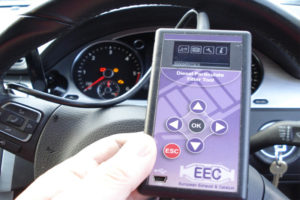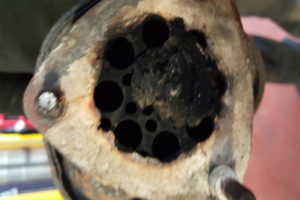Stuart Still, Technical Trainer at EEC explains why a faulty turbo can lead to DPF damage.
I regularly receive calls from workshops complaining that a customer’s vehicle is suffering from a ‘faulty’ or ‘blocked’ DPF. Now let’s get one thing straight: it’s very unusual for a DPF itself to be ‘faulty’, and in the vast majority of circumstances a DPF related issue will be caused by something else upstream of the component.
How to check
If triggered fault codes relate to the DPF being excessively blocked, with the DPF warning light illuminated and a lack of vehicle power, you should first check the vehicle’s mileage and the type of journeys that it covers. If the vehicle is mainly driven on short or stop-start routes then this can
cause the DPF to become blocked, as it’s never driven long enough to activate the ‘regeneration’ process.
When a vehicle fits into this category then its good practise to advise the owner that they drive the vehicle every six to eight weeks at over 2,500 RPM for about 20 to 25 minutes, as this will usually trigger the regeneration process. Alternatively you can use a diagnostic tool with the ability to carry out a
‘forced’ regeneration.
Aside from driving styles and techniques, there are plenty of other reasons that can lead to a blocked DPF. In the majority of cases this will be down to damaged or a defective component – such as the EGR valve, injectors, glow plugs or inlet manifold – so it is essential that these parts are serviced regularly and correctly. In cases where a DPF has been damaged as a result of a failed component elsewhere on the vehicle, the DPF is likely to need replacing at a substantial cost to the customer.
Turbo troubles
In recent times we’ve come across scenarios where a failed turbo has been the cause of a blocked DPF. Much like DPFs, good quality turbochargers are rarely faulty but for these components to perform effectively they must have the correct operating conditions within which to do so.
One common reason for turbo failure is oil contamination. As turbochargers can operate at over 6,000 revs per second (360,000 RPM) and endure temperatures of 950°C, turbo bearings are under great stress. The turbine shaft and bearings rotate in a thin film of oil, so any fault with the oil supply to
the turbo means its bearings are likely to fail before the engine’s main bearings. Running a turbo without oil for five seconds is as harmful as running an engine without oil for five minutes.

While it’s important to check the engine oil pressure meets the manufacturer’s specifications, it’s even more critical that the oil feed pipes to the turbo are clean and clear so you’re certain they can supply
uncontaminated oil, at the correct pressure. Contaminated or dirty oil will scratch or score the bearings, leading to rapid wear and, ultimately, turbocharger failure.
What causes contaminated oil?
1. A blocked, damaged or poor quality oil filter.
2. High carbon build-up in the engine. This can rapidly contaminate even new oil.
3. Accidental contamination of new oil during servicing.
4. A malfunctioning oil filter bypass valve.
5. Engine wear, leaving swarf deposits in the oil.
6. Oil that has degraded due to excessive temperatures or extended service intervals.
How to prevent turbo failures through oil contamination
a) Always use fresh oil and new oil filters (as recommended by the engine manufacturer) when fitting a new turbo.
b) Ensure the oil is the correct grade for the engine.
c) Clean or replace oil inlet pipes to eliminate any carbon deposits or sludge that could enter the turbo or restrict oil flow to the bearings.

Nowadays there are a growing number of remedies that can help to clean most engine and emissions related systems and components. These can be effective, but we recommend that if you’re cleaning anything upstream of the DPF then you should carry out a forced regeneration directly after administering these products. This can help to burn off the sludge/particulate matter/carbon
that may have been removed from the cleaned components, but are then deposited within the DPF. If they’re left to dry then they can set like concrete, with DPF damage the likely outcome.
Thank you to BTN Turbo for its assistance in producing this article.










